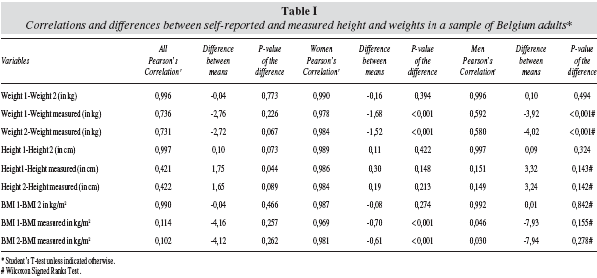Mi SciELO
Servicios Personalizados
Revista
Articulo
Indicadores
-
 Citado por SciELO
Citado por SciELO -
 Accesos
Accesos
Links relacionados
-
 Citado por Google
Citado por Google -
 Similares en
SciELO
Similares en
SciELO -
 Similares en Google
Similares en Google
Compartir
Nutrición Hospitalaria
versión On-line ISSN 1699-5198versión impresa ISSN 0212-1611
Nutr. Hosp. vol.24 no.3 Madrid may./jun. 2009
Reliability and validity of self-reported weight and height in Belgium
Confiabilidad y validez de pesos y tallas autovalorados en Bélgica
Recently some nutrition surveys rely on self-reported weights and heights for the estimation of bodymass-index' (BMI) based nutritional status, particularly when modern online data collection methods are applied.1 It is still under debate whether such procedures are valid or reliable. On the one hand, self-reported height and weight are considered as feasible, useful measures in large scale studies,2 while on the other hand, overestimation of self-reported height and underestimation of self-reported weight have been documented as a sources of individual bias independently of gender.3
The only way to evaluate performance of self-reported anthropometric information is by comparing those values against actual measures. Hence, a small-scale study was carried out in Belgium between March and April 2008 to assess the reliability and validity of such values. The convenience sample included 71 participants: 37 women (mean age 38 y; SD17) and 34 men (mean age 36 y; SD16). Each respondent had to fill a short socio-demographic questionnaire and register their weights and heights. Three weeks later, they were asked to repeat the exercise (test-retest reliability). University students weighed and measured each respondent according to standard procedures4 to obtain true values as reference.
Normality of data was assessed with the Kolmogorov-Smirnov test. Differences between self-reported and actual measures of height and weight were assessed using Student's T-test for normally distributed variables. The non-parametric Wilcoxon Signed Ranks Test was used to compare non-normally distributed variables. All tests were performed with a significance level of 0.05.
At an aggregated level all variables were normally distributed, with exception of measured height (P = 0.024). When evaluated by respondent's gender, all women's variables presented normal distribution, including estimated BMI. Men's self reported heights and weights were normally distributed; however, actual measures and corresponding calculated BMI were not.
Table I shows correlations and differences between self-reported and measured heights and weights in this sample. No statistical differences were found between self-reported weights and actual measures of weight. The difference between the first self-reported height and the actual measure was significant for the whole group. No statistical differences could be observed between first and second self-reported values and the consequent BMI estimate. For women all correlations between self-reported and measured values were significant, suggesting that females are more reliable in self assessment of height and weight. The opposite holds for males.
The paradoxical message of this study is that in this sample of Belgian adults, self reporting of heights and weights is reliable (respondents provided the same values twice) but not valid (inaccurate values) despite high correlations with actual measurements. As expected, overweight levels estimated on the basis of selfreported heights and weights would be underestimated.5 This limitation should be addressed when reporting results based on self-reported anthropometric data.
F. J. A. Pérez-Cueto & W. Verbeke
Ghent University. Department of Agricultural Economics. Ghent. Belgium.
References
1. Matthys C, Pynaert I, De Keyzer W, De Henauw S. Validity and reproducibility of an adolescent web-based food frequency questionnaire. J Am Diet Assoc 2007; 107 (4): 605-10. [ Links ]
2. Goodman E, Strauss RS. Self-reported height and weight and the definition of obesity in epidemiological studies. J Adolesc Health 2003; 33 (3): 140-141. [ Links ]
3. Danubio ME, Miranda G, Vinciguerra MG, Vecchi E, Rufo F. Comparison of self-reported and measured height and weight: Implications for obesity research among young adults. Econ Hum Biol 2008: 6 (1): 181. [ Links ]
4. WHO (World Health Organization) Physical Status: the use and interpretation of anthropometry. World Health Organization Technical Report Series, Editor. 1995: Geneva, pp. 375-411. [ Links ]
5. Gorber SC, Tremblay M, Moher D, Gorber B. Diagnostic in obesity comorbidities - A comparison of direct vs. self-report measures for assessing height, weight and body mass index: a systematic review. Obes Rev 2007: 8(4): 307-326. [ Links ]
![]() Correspondence:
Correspondence:
F. J. Armando Pérez-Cueto.
Postdoctoral Researcher.
Ghent University Department of Agricultural Economics.
Coupure Links 653, 9000 Ghent, Belgium.
E-mail: federico.perezcueto@ugent.be
Recibido: 27-I-2009.
Aceptado: 11-II-2009.















